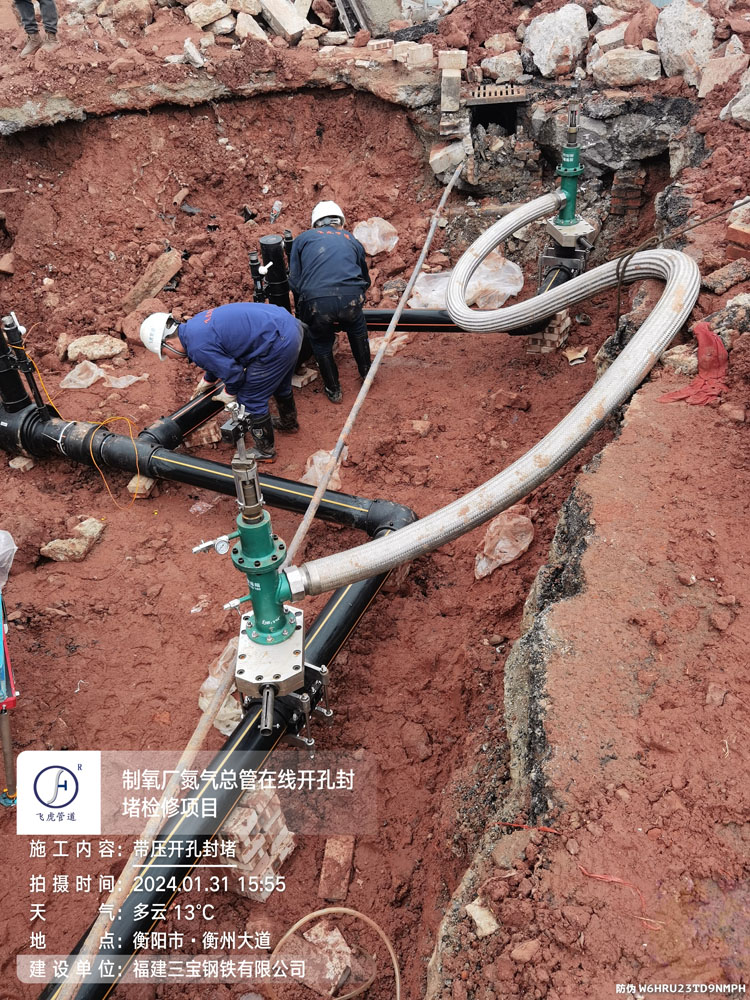What is PE Hot Tapping for HDPE Pipelines?
PE Hot Tapping for HDPE Pipelines is a specialized procedure that allows technicians to make new connections or access existing polyethylene pipelines without shutting down the system. This technique is especially important for high-demand utilities, such as gas, water, and industrial pipelines, where uninterrupted flow is critical. Hot tapping involves creating an entry point into a pressurized pipeline using specialized equipment while maintaining full service to customers. Unlike traditional methods that require depressurizing or cutting the pipe, PE hot tapping provides a controlled and safe way to expand or repair pipelines. For HDPE pipelines, which are widely used due to their durability, flexibility, and resistance to corrosion, this method has proven to be both reliable and efficient. Operators value it because it reduces costly downtime and avoids service disruptions that can affect thousands of users. The process has become an industry standard for pipeline maintenance and expansion projects that demand precision and safety.
How the PE Hot Tapping Process Works
The process of PE Hot Tapping for HDPE Pipelines involves several well-defined steps that ensure safety and efficiency. First, technicians prepare the pipeline by selecting the appropriate tapping location and installing a drilling saddle. The tapping machine is then attached to the saddle to create a precise opening in the live pipeline. Once the machine drills into the pipe wall, the flow is controlled, and a secure valve connection is established without interrupting service. During the operation, pressure and flow are continuously monitored to prevent leaks or hazards. Specialized sealing components are used to ensure that the joint remains strong and leak-free, even under varying pressure conditions. Every stage requires skilled technicians who are trained to manage live pipeline systems and follow strict safety protocols. The process demonstrates how engineering solutions can balance operational needs with safety and regulatory requirements.
Key Benefits of PE Hot Tapping for HDPE Pipelines
There are numerous advantages to using PE Hot Tapping for HDPE Pipelines, making it the preferred choice in modern infrastructure projects. One of the most important benefits is the ability to maintain continuous service while performing maintenance or adding new connections. For industries that cannot afford downtime, such as gas distribution or municipal water supply, this advantage is critical. Cost savings are another major benefit, since shutting down and restarting an entire pipeline system can be time-consuming and expensive. Environmental protection is also enhanced, as hot tapping reduces the risk of spills, leaks, or emissions that often occur during depressurization. The process is highly versatile and can be adapted to pipelines of different sizes, pressures, and applications. Additionally, hot tapping supports long-term efficiency by allowing pipelines to be upgraded or expanded without major interruptions. These combined benefits make PE hot tapping an essential tool in the modern pipeline maintenance toolkit.
Applications of PE Hot Tapping in Different Sectors
The applications of PE Hot Tapping for HDPE Pipelines extend across a wide range of industries and infrastructure systems. Municipal water supply systems often use this method to add new service lines or perform repairs without shutting off water to entire neighborhoods. In natural gas distribution networks, hot tapping is crucial for maintaining uninterrupted service to homes and businesses while expanding pipelines to new areas. Industrial facilities that rely on high-pressure HDPE pipelines also use this process to make modifications while keeping their operations fully functional. Emergency repairs benefit from hot tapping because technicians can quickly access the pipeline without scheduling extended downtime. Infrastructure projects in urban areas, where demand is constantly growing, increasingly rely on hot tapping to support expansion with minimal disruption. By meeting the needs of diverse sectors, this technique has proven its adaptability and importance in today’s pipeline operations. The growing reliance on hot tapping reflects its effectiveness in balancing safety, service continuity, and cost efficiency.
Safety and Compliance in PE Hot Tapping
Safety is one of the most critical aspects of performing PE Hot Tapping for HDPE Pipelines. Working on live, pressurized systems requires precise planning and strict adherence to safety protocols. Certified technicians must be involved in every stage, from equipment setup to monitoring pressure during the drilling process. Regulatory compliance is also essential, as pipeline work is governed by industry standards designed to protect both workers and communities. Common risks, such as leaks, pressure surges, or equipment malfunction, are mitigated by using advanced sealing technologies and conducting thorough inspections before, during, and after the procedure. Environmental safety is another factor, since hot tapping eliminates the need to release potentially hazardous substances into the surroundings. Following these standards ensures that the process is not only effective but also aligned with best practices in occupational and environmental safety. Compliance builds confidence among pipeline operators and ensures reliable service delivery to customers.
Challenges and Technical Considerations
Although PE Hot Tapping for HDPE Pipelines offers many advantages, there are technical challenges that must be addressed for successful execution. One challenge is ensuring material compatibility, as HDPE requires specific saddles and seals that can withstand long-term use under pressure. Another consideration is managing different pipeline pressures and temperatures, which affect how the tapping machine operates and seals the connection. Choosing the correct equipment for each project is vital, as using the wrong tools can compromise both safety and durability. Ensuring the long-term strength of the hot tap connection is also critical, requiring high-quality materials and precise installation techniques. Technicians must be trained to handle unexpected conditions, such as variations in pipeline thickness or signs of wear. Additionally, accurate monitoring during the procedure is necessary to prevent risks like pressure imbalance. By addressing these challenges with careful planning and technical expertise, hot tapping can remain a dependable solution for HDPE pipeline projects.
Future of PE Hot Tapping for HDPE Pipelines
The future of PE Hot Tapping for HDPE Pipelines is shaped by ongoing innovation and growing demand for efficient pipeline solutions. Advances in tapping machine technology are making the process faster, safer, and more precise than ever before. Integration with smart monitoring systems allows operators to gather real-time data on pressure, flow, and pipeline conditions, improving decision-making. Sustainability is also influencing developments, as industries seek environmentally responsible practices that reduce risks and waste. Future innovations may include stronger sealing materials, automated tapping equipment, and AI-driven monitoring systems that predict maintenance needs. As global infrastructure expands, the need for reliable and cost-effective pipeline access will continue to grow, particularly in urban areas. These trends suggest that hot tapping will remain a cornerstone of pipeline maintenance and expansion in the decades to come. With continuous improvements, this method will meet the rising demands for safety, efficiency, and environmental responsibility.
Frequently Asked Questions (FAQ)
What size pipelines can be hot tapped safely?
PE hot tapping can be performed on a wide range of HDPE pipeline diameters. The exact limits depend on the tapping equipment and project requirements, but the method is adaptable to small, medium, and large-scale systems.
Can PE hot tapping be done on older HDPE pipelines?
Yes, but technicians must carefully inspect older pipelines to ensure they can handle the procedure. Reinforcement or special sealing components may be required to guarantee long-term reliability.
How long does the process usually take?
The duration varies based on pipeline size, pressure, and the complexity of the connection. In many cases, hot tapping can be completed in just a few hours, making it far quicker than shutting down and restarting a system.
What are the main risks involved in hot tapping?
The primary risks include leaks, pressure surges, or improper sealing. However, these risks are minimized when certified technicians follow established protocols and use high-quality equipment.
How does PE hot tapping compare to other pipeline connection methods?
It is generally safer and more cost-effective than traditional shutdown-based methods. By maintaining continuous service and avoiding depressurization, hot tapping reduces both downtime and environmental impact.

